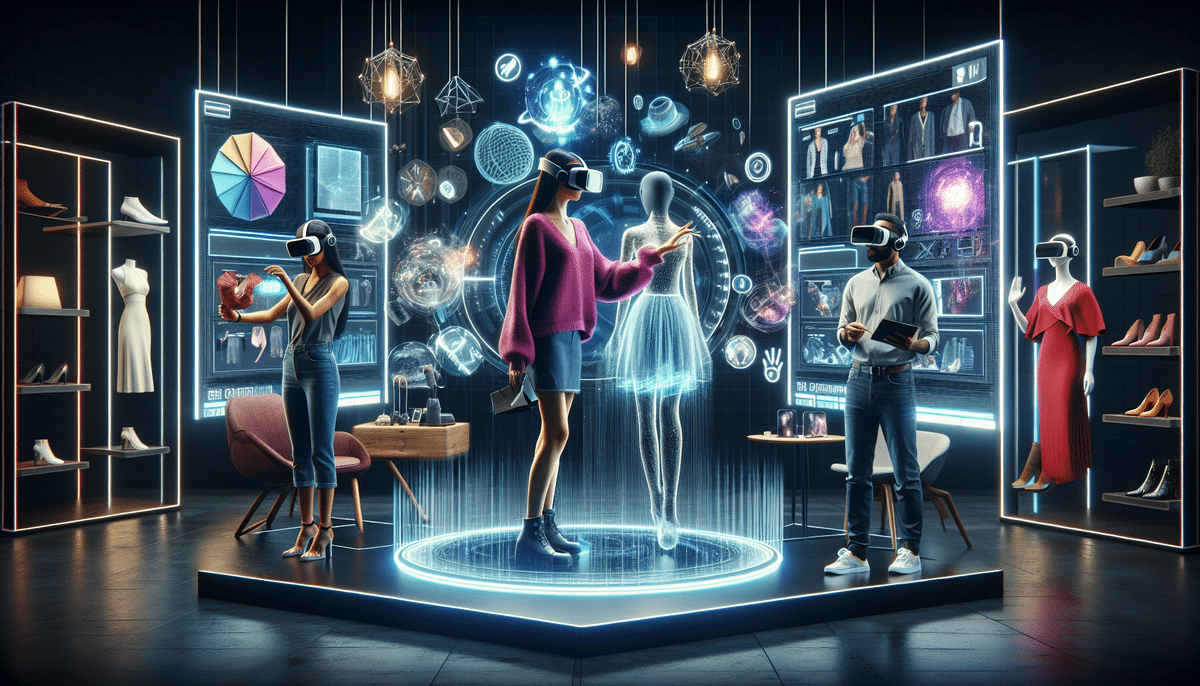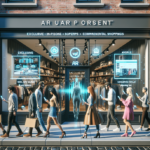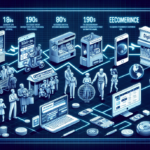How Virtual Reality is Drastically Enhancing the Ecommerce Shopping Experience
The ecommerce industry has been growing exponentially over the past few years. According to Statista, global ecommerce sales reached approximately $5.7 trillion in 2022, and this trend is expected to continue upward. However, as online shopping becomes more popular, retailers face the challenge of providing a satisfying customer experience in the digital space. This is where virtual reality (VR) comes into play. The integration of virtual reality in ecommerce has brought about a revolutionary change in the way customers shop online. The benefits of VR in ecommerce shopping are vast, and the technology is rapidly gaining ground. In this article, we’ll explore the different ways in which virtual reality is enhancing the ecommerce shopping experience.
The Benefits of Virtual Reality in Ecommerce Shopping
The benefits of virtual reality technology in ecommerce shopping are immense. Virtual reality enables customers to view and interact with products in a more immersive and engaging way. While traditional online shopping relies on 2D product images and descriptions, virtual reality provides a 3D experience that allows customers to see every aspect of a product before making a purchase. This enhances the overall customer experience, creating a more personalized and interactive e-commerce environment.
Moreover, virtual reality technology can also help reduce the number of product returns. With traditional online shopping, customers may receive a product that looks different from what they expected, leading to dissatisfaction and returns. However, with virtual reality, customers can see the product in a more realistic way, reducing the chances of receiving a product that does not meet their expectations. This not only saves time and money for both the customer and the retailer but also helps to build trust and loyalty between the two parties.
Immersive Shopping: How Virtual Reality is Changing the Game
One of the main benefits of virtual reality in ecommerce is its ability to create a fully immersive shopping experience. With VR, customers can enter a virtual store, browse products, and interact with items as if they were in a physical store. This allows customers to get a better understanding of a product before they buy it. They can look at details, see how it works, test its functionality, and even get a sense of its size. Immersive shopping is taking online shopping to the next level, creating a more engaging and interactive experience for customers.
Moreover, virtual reality in ecommerce is also changing the way customers make purchasing decisions. With immersive shopping, customers can visualize how a product would fit into their lives, homes, or wardrobes. This helps them make more informed decisions and reduces the likelihood of returns. Additionally, virtual reality can also be used to create personalized shopping experiences. By analyzing customer data, retailers can create virtual stores tailored to individual preferences, making the shopping experience even more enjoyable and efficient.
The Future of Ecommerce: Virtual Reality Shopping
Virtual reality shopping has promising potential for the future of ecommerce. Customers can shop online without the limitations of physical stores. Virtual reality technology can bring a virtual store into customers' homes, allowing them to shop at any time, from anywhere. This has the potential to significantly increase sales, as more customers can access products from the comfort of their homes.
Moreover, virtual reality shopping can provide a more immersive and interactive experience for customers. They can view products in 3D, try them on virtually, and even see how they would look in their own homes. For instance, IKEA’s IKEA Place app allows users to visualize furniture in their space using augmented reality, which is a complementary technology to VR.
Another benefit of virtual reality shopping is the potential for personalized experiences. Retailers can use data and analytics to create customized virtual stores for individual customers, based on their preferences and shopping history. This can lead to increased customer loyalty and repeat business. According to a report by McKinsey, personalized shopping experiences can drive significant growth in customer satisfaction and sales.
Virtual Try-On: A New Era in Online Shopping
Virtual try-on is a new era in online shopping. With this technology, customers can try on clothes and accessories in a virtual environment, without having to physically go to a store. This eliminates the need for customers to second-guess how a product will look on them, leading to fewer product returns. Virtual try-on is rapidly becoming a crucial tool for fashion brands. Major retailers like Zara and H&M are already implementing this technology, and it is only a matter of time before it becomes a widespread feature of the ecommerce industry.
Virtual try-on technology is not limited to just clothing and accessories. It is also being used in the beauty industry, allowing customers to try on makeup virtually before making a purchase. This technology is particularly useful for customers who are hesitant to try new makeup products due to concerns about how they will look on their skin. With virtual try-on, customers can experiment with different shades and products without any risk. L'Oréal has been a pioneer in integrating augmented and virtual reality in their online beauty retailing, revolutionizing how consumers shop for beauty products.
Boosting Sales and Customer Engagement with VR Technology
Virtual reality technology has the potential to significantly increase sales while also improving customer engagement and satisfaction. Research from Forbes shows that customers are more likely to purchase products that they can engage with in a more immersive way. This is why virtual reality is becoming an increasingly popular tool for retailers. The use of virtual reality technology is proving to be an effective way to increase customer engagement, as well as boost sales.
One of the key benefits of using virtual reality technology is that it allows customers to experience products in a way that is not possible with traditional marketing methods. For example, a customer can try on clothes virtually, see how furniture would look in their home, or even test drive a car without leaving the store. This not only increases the likelihood of a sale, but it also enhances the overall customer experience.
Another advantage of using virtual reality technology is that it can help retailers to stand out from their competitors. By offering a unique and innovative shopping experience, retailers can differentiate themselves from other businesses in their industry. This can help to attract new customers and retain existing ones, ultimately leading to increased sales and revenue.
The Psychology Behind the Success of Virtual Reality Shopping
There is a psychological explanation behind the success of virtual reality shopping. Virtual reality creates a sense of presence, which triggers emotions and responses in customers that are similar to those they would experience in a physical store. The technology enables customers to establish a better connection with a product, making them more likely to purchase it. This is because virtual reality provides a more tangible experience than simple 2D product images and descriptions.
Studies have shown that immersive experiences can significantly enhance memory retention and emotional engagement. According to research published in the Journal of Consumer Psychology, consumers are more likely to develop positive feelings towards brands that offer immersive and interactive shopping experiences.
How VR is Solving Online Shopping's Biggest Problem - Product Returns
Product returns are one of the biggest problems faced by ecommerce retailers, accounting for approximately 30% of online sales. However, virtual reality has the potential to solve this problem. With virtual reality, customers can see products in detail and interact with them before purchasing. This reduces the likelihood of returns, as customers are better able to gauge how a product will meet their expectations.
By providing a more accurate representation of products, VR helps bridge the gap between online and in-store shopping experiences. This not only enhances customer satisfaction but also significantly reduces the costs associated with processing returns.
The Role of VR in Personalizing the Ecommerce Experience
Personalization is an essential aspect of the modern shopping experience. Virtual reality technology can provide a more personalized experience for customers, as it enables retailers to analyze customer data and create tailored shopping experiences. The more personalized the experience, the more satisfied customers feel, leading to increased customer loyalty and retention.
For example, VR can adapt the virtual store layout based on individual shopping behaviors, recommend products in a more interactive manner, and even adjust the virtual environment to match the customer's preferences. According to a report by PwC, personalized shopping experiences can boost conversion rates by up to 20%.
How Brands are Utilizing VR to Create Unique and Memorable Customer Experiences
Major brands are utilizing virtual reality technology to create unique and memorable customer experiences. For instance, Jaguar Land Rover implemented a virtual reality experience, allowing customers to explore the interior and exterior of their cars before purchasing. This provided a unique experience for customers, which was memorable and engaging.
Retailers across various industries are now capitalizing on virtual reality technology to create distinctive and unforgettable shopping experiences. From virtual fashion shows to interactive product demonstrations, brands are leveraging VR to differentiate themselves in a competitive market.
From Showrooms to Virtual Reality: The Evolution of Retail Spaces
The integration of virtual reality technology in ecommerce has transformed the retail industry. It has enabled retailers to create virtual showrooms and product displays, offering customers the chance to interact with products in ways that weren't possible before. With virtual reality, the boundaries of physical spaces are removed, allowing retailers to provide a more comprehensive shopping experience that is not restricted by physical store limitations.
This evolution is particularly beneficial for small and medium-sized enterprises (SMEs) that may not have the resources to maintain extensive physical storefronts. Virtual showrooms provide an accessible platform for these businesses to reach a wider audience without the overhead costs associated with traditional retail spaces.
The Impact of VR on Consumer Behavior in the Ecommerce Industry
The integration of virtual reality has had a significant impact on consumer behavior in the ecommerce industry. Research from McKinsey suggests that the use of virtual reality technology improves customer engagement, which, in turn, leads to increased sales. Customers are more likely to make purchases when they can interact with products in a more immersive way. This technology has also helped to reduce the number of product returns, which is a significant issue faced by ecommerce retailers.
Additionally, VR has influenced how consumers perceive brand value and trust. By offering an engaging and interactive shopping experience, brands can enhance their reputation and foster stronger relationships with customers.
Overcoming Obstacles: Implementing VR Technology in Ecommerce
Implementing virtual reality technology in ecommerce comes with its own unique set of challenges. Retailers need to invest in the technology and ensure that it is integrated successfully into their ecommerce platform. There is also a need to train staff and educate customers on how to use the technology. However, the benefits of virtual reality in ecommerce make it well worth the investment, and retailers that successfully incorporate this technology will have a competitive edge in the market.
Key challenges include the high initial cost of VR setup, the need for high-quality 3D product models, and ensuring compatibility across various devices and platforms. Despite these obstacles, advancements in VR technology and decreasing costs are making it more accessible for businesses of all sizes.
A Comparative Analysis: Traditional Online Shopping vs Virtual Reality Shopping
Traditional online shopping relies heavily on 2D product images and descriptions, which can be limiting for customers. Virtual reality shopping, on the other hand, provides a more immersive and comprehensive shopping experience that allows customers to interact with products in a more tangible way. The use of virtual reality in ecommerce has made it possible for customers to shop online in a way that is almost indistinguishable from shopping in a physical store. This has led to increased customer engagement, satisfaction, and sales.
- Engagement: VR offers a more engaging experience compared to static images and videos.
- Understanding Products: Customers can better understand product features and functionalities through interactive VR experiences.
- Decision Making: Enhanced visualization aids in making more informed purchasing decisions.
- Customer Satisfaction: Higher satisfaction rates due to accurate product representation and reduced returns.
Preparing for the Future: Investing in VR Technology for Your Ecommerce Business
The future of ecommerce is bright, and virtual reality technology is poised to play a significant role in it. Investing in virtual reality technology will enable retailers to stay ahead of the curve and provide customers with an immersive shopping experience that is impossible to replicate in a physical store. This investment, although costly, could bring significant returns in the future. Virtual reality technology ensures that retailers remain competitive and can offer customers the best possible shopping experience.
To effectively integrate VR into their ecommerce strategy, businesses should:
- Conduct thorough market research to understand customer needs and preferences.
- Invest in high-quality VR hardware and software solutions.
- Train staff to manage and maintain VR systems.
- Continuously gather and analyze customer feedback to refine the VR experience.
By taking these steps, retailers can harness the full potential of virtual reality to transform their ecommerce operations.
Conclusion
Virtual reality technology is transforming the ecommerce industry. It is providing customers with an immersive and engaging shopping experience that is not possible with traditional online shopping. The benefits of virtual reality in ecommerce are vast, ranging from improved customer engagement and satisfaction to reduced product returns. Retailers that adopt virtual reality technology in their ecommerce business will have a competitive edge in the market. This technology promises to revolutionize the way customers shop online, making it more personalized, interactive, and memorable.






















